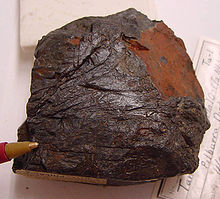Tantalite
| Tantalite | |
|---|---|
 Tantalite, Pilbara district, Australia | |
| General | |
| Category | Oxide minerals |
| Formula (repeating unit) | (Fe,Mn)Ta2O6 |
| Strunz classification | 4.DB.35 |
| Crystal system | Orthorhombic |
| Space group | Orthorhombic - dipyramidal H-M symbol (2/m 2/m 2/m) |
| Identification | |
| Color | Dark black, iron-black to dark brown, reddish brown |
| Cleavage | Good in one direction |
| Fracture | Subconchoidal |
| Mohs scale hardness | 6-6.5 |
| Luster | Submetallic to almost resinous |
| Streak | Brownish-red to black |
| Specific gravity | 8.0+ |
| References | [1][2] |

The mineral group tantalite [(Fe, Mn)Ta2O6] is the primary source of the chemical element tantalum. It is chemically similar to columbite, and the two are often grouped together as a semi-singular mineral called coltan or "columbite-tantalite" in many mineral guides. However, tantalite has a much greater specific gravity than columbite (8.0+ compared to columbite's 5.2).[2] Iron-rich tantalite is the mineral tantalite-(Fe) or ferrotantalite and manganese-rich is tantalite-(Mn) or manganotantalite.
Tantalite is also very close to tapiolite. Those minerals have same chemical composition, but different crystal symmetry orthorhombic for tantalite and tetragonal for tapiolite.[3]
Tantalite is black to brown in both color and streak. Manganese-rich tantalites can be brown and translucent.
Occurrence
Tantalite has been found in Australia, Brazil, Canada, Colombia (Guainía and Vichada), Egypt, northern Europe, Madagascar, Namibia, Nigeria, Rwanda, the United States (California, Colorado, Maine, and Virginia), and Zimbabwe. Brazil has the world's largest reserve of tantalite (52.1%).[4] In 2006, 75% of world tantalite production came from Australia.[4]
Sustainability
The mining of tantalite causes many ecological and social problems in Democratic Republic of Congo.[5][6]
References
- ^ "TANTALITE (Iron Manganese Tantalum Niobium Oxide)". Galleries.com. Retrieved 2011-10-25.
- ^ a b Tantalite. Mindat.org (2011-09-07). Retrieved on 2011-10-30.
- ^ P. Cerny; et al. (1992). "The tantalite-tapiolite gap: natural assemblages versus experimental data" (PDF). Canadian Mineralogist. 30: 587.
- ^ a b Papp, John F. (2006). "2006 Minerals Yearbook Nb & Ta". US Geological Survey. Retrieved 2008-06-03.
- ^ Coltan, Gorillas and cellphones. Cellular-news.com (2001-04-03). Retrieved on 2011-10-30.
- ^ The Coltan Scandal. Geology.about.com (2010-07-04). Retrieved on 2011-10-30.
